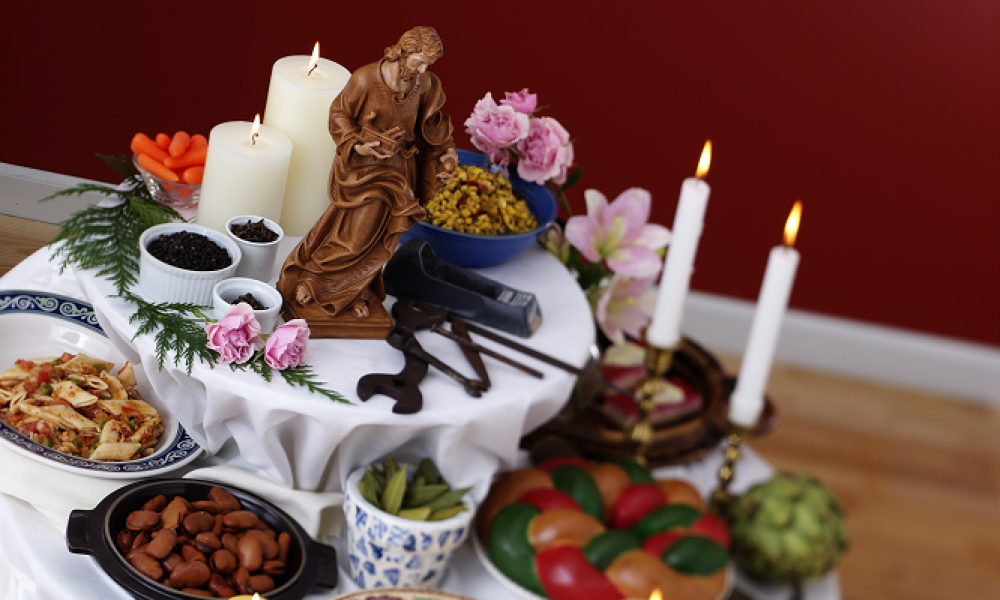
St. Joseph’s Table
A miracle from the Middle Ages inspires us to feed the less fortunate
A miracle from the Middle Ages inspires us to feed the less fortunate
Legend has it that St. Joseph – patron of fathers, carpenters, social justice, and the Universal Church – also had a hand in saving Sicily from a terrible drought.
It was during the Middle Ages that the drought occurred, killing the crops and putting the people of this Italian island in peril. Only the lowly fava bean, then grown as animal fodder, survived and became the sustaining food of the farmers and their families.
But the Sicilians knew they couldn’t go on with just one thing to eat. In desperation, they prayed to St. Joseph for help; as protector of the Holy Family, he was thought to be the most appropriate saint to intercede on their behalf. Shortly thereafter, the rains came down and the harvest was saved.
In thanksgiving, the people gathered the first fruits and grains, had them blessed, and offered them to St. Joseph on his feast day, March 19. Every year since, Sicilians in Europe and around the world have repeated this tradition by preparing a tavola di San Giuseppe (St. Joseph’s table) in the great saint’s honor.
You can join in this tradition at your church or even in your home. To prepare for it, you need to set up a three-tiered table (symbolizing the Holy Trinity). Then cover the table with a white cloth and decorate it with a statue of St. Joseph and symbols of his craft: hammers, saws, and other woodworking tools.
The flower of choice for a St. Joseph’s table is a lily, though other seasonal blooms may be used. Candles of varying heights may also be placed on the tiers, to help to illuminate the display.
Then comes the food – and lots of it. Since St. Joseph’s feast day falls during Lent, the table’s dishes are often meatless. Fish, pasta, and vegetable dishes are common; stuffed artichokes are a particular favorite. So are breads fashioned into a variety of sizes and shapes including monstrances, chalices, crosses, staffs, and wreaths. Bread crumbs or mudica are often sprinkled on the food and on the table to symbolize the sawdust from St. Joseph’s workshop.
Pastries also have their place at this celebration; among the most popular are sfingi (cream puffs flavored with lemon and orange rinds) and a fried shortbread sweet filled with jam or almond paste.
The display, though beautiful to look at, is meant to be shared with others; in Sicily, the foods are blessed and distributed to those less fortunate in the community.
If you visit a traditional St. Joseph’s table, you’ll likely walk away with a gift of fava beans – the food that saved the Sicilians from starvation.
Following is a recipe that incorporates this famous bean in a savory broth that blends garlic, cloves, coriander, and peppercorns.
Fava Bean and Vegetable Soup
Yield: 6-8 servings
1 1/4 lbs. shelled and skinned fresh fava beans, or 8 oz. dry fava beans
3 stalks celery, washed, tops trimmed and saved and stalks cut into 1/4-inch slices
6 large garlic cloves, crushed with skin
12-18 black peppercorns
2-3 sprigs fresh coriander, oregano or Italian parsley
1 bay leaf
8 whole cloves
8 cups water, chicken stock or beef stock
2 Tblsp coarse salt
1 onion, peeled and cut into 1/4-inch cubes
1 carrot, peeled and cut into 1/4-inch cubes
1 potato, peeled and cut into 1/4-inch cubes
2 Tblsp chopped coriander or Italian parsley
In a stockpot, place the celery tops, crushed garlic cloves, peppercorns, coriander, oregano or Italian parsley, bay leaf, cloves, water or stock, and salt and bring to a boil. Lower the heat, cover the stockpot, and simmer for 30 minutes. Remove from heat and strain through a fine sieve. Measure the broth. You should have 6 cups. If not, add enough water or extra stock to make 6 cups.
In a saucepan, add the broth, onion, carrot, sliced celery, and potato and bring to a boil. Lower the heat and let simmer for 8 minutes. Add the fava beans and continue to simmer for another 5 minutes or until the beans are barely cooked. Remove from heat. Season with more salt to taste. Serve hot, garnished with coriander or Italian parsley.
NOTE: If you prefer dry fava beans, soak them overnight with enough cold water to cover, then drain and use as you would the fresh beans.
From the Blessing of St. Joseph’s Table (The Book of Blessings)
All-provident God,
the good things that grace
this table remind us of your many good gifts.
Bless this food, and may the prayers of St. Joseph, who
provided bread for your son and food for the poor, sustain us and all our brothers and sisters
on our journey towards your
heavenly kingdom.
We ask this through
Christ our Lord. Amen.



